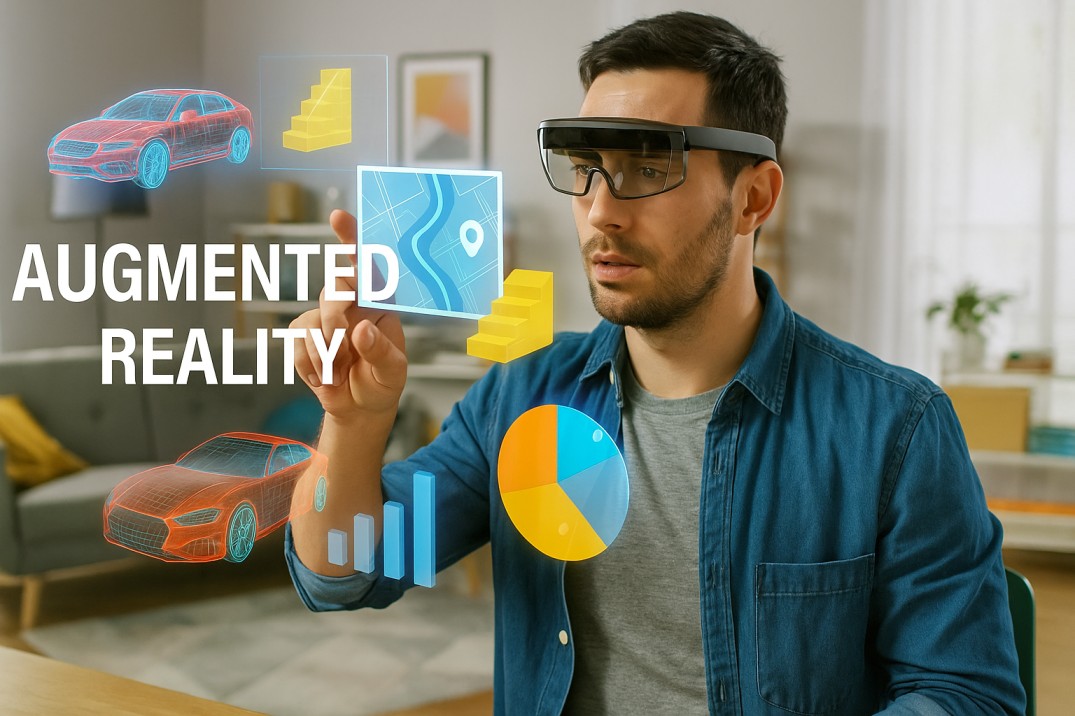The rapid growth of technology means that Augmented Reality (AR) is no longer a figment of our imagination; it is a vital part of how we communicate and engage with the surroundings. Whether it’s in immersive gaming or real-time navigation, AR is gradually but surely embedding itself into our daily lives and industries swimmingly.
What is Augmented Reality?
Augmented Reality is the use of digital information—images, sound, and other materials—in real-life context. This differs from Virtual Reality (VR) whereby a simulated environment replaces all recognizable factors in reality. Instead of replacing place, AR simply gives it more enlivening flair with the addition of digital models to the space.
Think Pokémon GO, or Snapchat filters, or IKEA’s app which allows one to view furniture in your room prior to purchasing it, that is the idea of AR.
The Development of Augmented Reality (AR): an Overview
While AR seems to have emerged overnight, AR in itself is the result of research and investment that has been happening since the 1960’s. With the increase in computing size and power, camera technology, and presence of mobile devices, AR is finally becoming commonplace.
Some important timelines include:
- 1990: Boeing researcher Tom Caudell was observing how people had to process vast amounts of information on a work site, and he was able to offer up the term Augmented Reality (AR) to define its importance in the human context.
- 2012: Google pursued augmented reality for the first time with AR Google Glass.
- 2016: The initial cultural introduction of AR happened with the launch of Pokémon GO.
- Today: Organizations are using augmented reality in so many ways, education, healthcare, etc…… for manufacturing and e-commerce.
Real Life Applications of Augmented Reality
1. Retail & E-Commerce :
With online shopping, augmented reality is changing the way we shop online. For instance, several brands, like Sephora and L’Oreal allow an option to “try on” makeup virtually. IKEA has incorporated AR so consumers can effectively visualize their product in their environment.
2. Healthcare
For healthcare providers, overlaying anatomical data on to patients data allows medical professionals to make better diagnosis or surgical planning. Additionally, augmented reality can also look to pair with medical education to utilize in allowing trainees to simulate procedures that are very complex.
3. Education
Augmented reality applications help to create a fun and interactive way to learn. For example, if a learner point their tablet at images in a textbook, it can unlock a 3D model that becomes “alive” when viewed through the intended device. Ultimately, it allows learners to experience the abstract that becomes real which has been shown to support learning better than reading.
4. Real Estate & Architecture
Real estate and architecture present applications for AR to conduct virtual walkthroughs of properties, while also allowing clients to visualize independently three-dimensional architectural design. This allows clients an experience of the finished product, prior to construction ever taking place.
The Future of AR: What’s Next?
The AR landscape is set to explode with the rise of AR glasses, 5G connectivity, and AI integration. Companies like Apple, Meta, and Microsoft are heavily investing in AR hardware and ecosystems.
In the near future, we may see:
- AR-powered navigation glasses replacing smartphone GPS.
- Enhanced workplace collaboration through shared AR workspaces.
- Hyper-personalized marketing based on real-time AR engagement.
Challenges and Considerations
AR demonstrates great potential but must overcome some challenges, including:
- Privacy and security considerations.
- Significant costs of creating high quality AR experiences.
- Devices and performance limits.
However, with the advancement of technology, a lot of these challenges are getting better and better.


3 thoughts on “Augmented Reality for Business and Beyond: A Practical Guide”